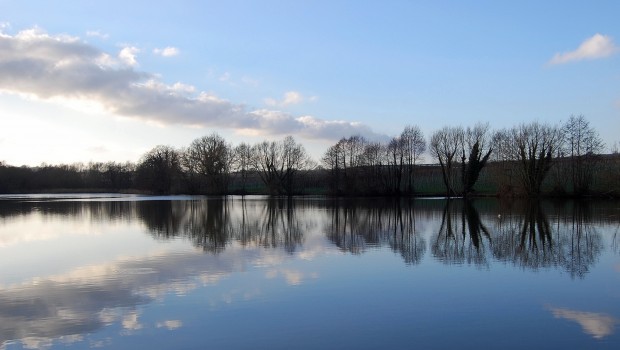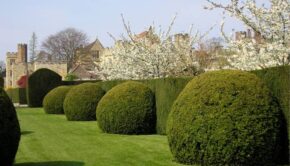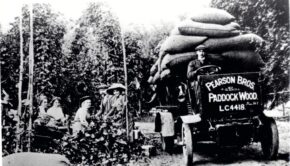Furnace Pond An extract from Hammer and Furnace Ponds, Relics of the Wealden Iron Industry, By Helen Pearce
The spectacular furnace pond just outside the village of Horsmonden is blessed with an abundance of waterfowl and other wildlife, making it a great place to stop and unwind during a tour of the area. It’s hard to imagine that this was once a bustling site of heavy industry rather than scenic or tranquil. The footpath here, part of the High Weald Landscape Trail, runs along the original dam and the footbridge passes over a spillway gushing down stone tiers – the famous Horsmonden Waterfall – to what was once a blast furnace site.
Furnace ponds are not natural lakes but dammed streams, crucial to the Tudor and Stuart iron industry in the High Weald, a major iron-producing region long before the Romans arrived. From the end of the 15th century new developments in iron smelting required massive heads of impounded waters to be channelled into waterwheels which powered huge bellows serving blast furnaces. Now molten iron could be poured straight into sand moulds, forming pig or ‘sow’ bars weighing up to half a ton, and other cast-iron items. Mass production was now possible, and soon innovations in gun casting ensured the main impetus for the industry was cannon manufacture.
Horsmonden, also known as Brenchley, Furnace was operating by 1564 and soon became one of the major ordnance producers in the area. Cannon were despatched from here via the River Medway to Maidstone and then shipped on to the Tower of London, where some can still be seen on display in the White Tower. Of the various owners and gun founders John Browne, Crown ordnance supplier, was famous for smelting experiments with bronze and air furnaces, and for producing guns for both Charles I and later Cromwell’s Commonwealth. At one point Browne claimed to employ 200 men, and gradually the present Horsmonden village grew up around the busy furnace and foundry works, most of which lie within the parish of Brenchley. A plain cast iron slab with brass plate commemorates John Browne’s wife Martha in St Margaret’s Church, south at the original Horsmonden.
By the end of the 18th century the Wealden iron industry had declined, unable to compete with cheaper foreign iron or the new coke-fuelled furnaces in the Midlands. Now the only clue to Horsmonden Furnace Pond’s industrial past is a large bear – a clump of waste iron and slag – which depending on overgrowth can be seen isolated in a midstream pool beneath the waterfall.
Over 180 furnaces and associated forges once operated over Sussex, Kent and Surrey, but most ponds have long been dry. Less than a handful survive in Kent, namely Horsmonden, Cowden, and Bayham Abbey Forge Pond on the county border. Biddenden, Cranbrook, Goudhurst, and Hawkhurst also served the industry while the railings around St Paul’s Cathedral were cast at Gloucester Furnace, near Lamberhurst.
Pearce, Helen, Hammer and Furnace Ponds, Relics of the Wealden Iron Industry, Pomegranate Press, 2012 ISBN 978-1907242151
Wealden Iron Research Group www.wealdeniron.org.uk






Comments